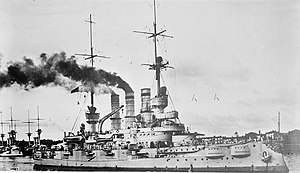 SMS Hannover's sister ship Schlesien
| |
| History | |
|---|---|
| Name | Hannover |
| Namesake | Province of Hanover |
| Ordered | 1 June 1904 |
| Builder | Kaiserliche Werft Wilhelmshaven |
| Laid down | 7 November 1904 |
| Launched | 29 September 1905 |
| Commissioned | 1 October 1907 |
| Recommissioned | 10 February 1921 |
| Decommissioned |
|
| Stricken | 1936 |
| Fate | Scrapped between 1944 and 1946 in Bremerhaven |
| General characteristics | |
| Class and type | Deutschland-class pre-dreadnought battleship |
| Displacement | |
| Length | 127.6 m (418 ft 8 in) |
| Beam | 22.2 m (72 ft 10 in) |
| Draft | 8.21 m (26 ft 11 in) |
| Installed power |
|
| Propulsion |
|
| Speed | 18 knots (33 km/h; 21 mph) |
| Range | 4,520 nmi (8,370 km; 5,200 mi) at 10 knots (19 km/h; 12 mph) |
| Complement |
|
| Armament |
|
| Armor | |
SMS Hannover[a] ("His Majesty's Ship Hannover") was the second of five Deutschland-class pre-dreadnought battleships of the German Imperial Navy (Kaiserliche Marine). Hannover and the three subsequently constructed ships differed slightly from the lead ship Deutschland in their propulsion systems and slightly thicker armor. Hannover was laid down in November 1904, launched in May 1905, and commissioned into the High Seas Fleet in October 1907. The ship was armed with a battery of four 28 cm (11 in) guns and had a top speed of 18 knots (33 km/h; 21 mph). The ships of her class were already outdated by the time they entered service, being inferior in size, armor, firepower, and speed to the revolutionary new British battleship HMS Dreadnought.
Hannover and her sister ships saw extensive service with the fleet. The ship took part in all major training maneuvers until World War I broke out in July 1914. Hannover and her sisters were immediately pressed into guard duties at the mouth of the Elbe River while the rest of the fleet mobilized. The ship took part in several fleet advances, which culminated in the Battle of Jutland on 31 May – 1 June 1916. During the battle, Hannover served as the flagship for IV Division of II Battle Squadron; she was not heavily engaged during the battle, nor was she damaged by enemy fire. After the battle, which exposed the weakness of pre-dreadnoughts like Hannover, she and her three surviving sisters were removed from active duty with the fleet to serve as guard ships. Hannover served in this capacity for the remainder of the war, first in the Elbe and, starting in 1917, in the Danish straits. She was decommissioned in December 1918, shortly after the end of the war.
The ship was brought back to active service in the Reichsmarine, the post-war German navy. She served with the fleet for ten years, from 1921 to 1931, during which time she took part in several major overseas cruises to Spain and the Mediterranean Sea. Hannover was again decommissioned in September 1931; the navy planned to convert the ship into a radio-controlled target ship, but this was never carried out and she was instead used in explosive tests. Hannover was ultimately broken up for scrap between 1944 and 1946 in Bremerhaven. Her bell is preserved at the Military History Museum of the Bundeswehr in Dresden.
Cite error: There are <ref group=lower-alpha> tags or {{efn}} templates on this page, but the references will not show without a {{reflist|group=lower-alpha}} template or {{notelist}} template (see the help page).